-
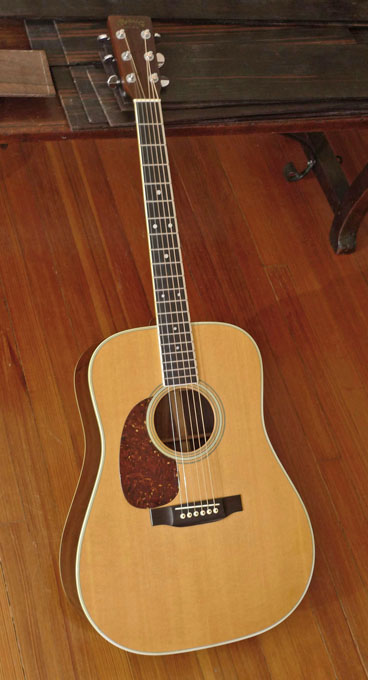 This is a wonderful, original from the factory "Lefty", a 1975 D-35L. Lefty's from this period are rare. Before the era of computerized factories, and the intro of the CNC machines at Martin, a high-end Lefty like this one was essentially a custom-made guitar. The bracing in this guitar was custom designed and built at the Martin factory for a true lefty top– this is not a regular D-35 with just different saddle and pickguard. It's built as a left-handed guitar, down to every brace. This guitar is in about as close to mint condition as you can get. The original black pickguard was lifting a bit (not from wear, there wasn't any– but just because Martin used some odd pickguard material in those years), so we just thought it would be cool to replace it with a vintage 30s style tortoise guard. I had John Allison cut a new guard, using period correct (1930's that is) nitrocellulose material. It looks great. (and BTW it's on the exact footprint of the original guard– they nudged them up a bit closer to the bridge on lefty's). This guitar sounds great. Fine, ringing trebles. Beautiful mids. It's one of the best D-35's we've played, from any period. And again, the condition is just almost mint. No cracks. No checking of finish. Everything except the pickguard is 100% original. It comes in its original hard shell Martin case, and original Martin literature from the Factory. The neck is straight, and action is perfect.
This is a wonderful, original from the factory "Lefty", a 1975 D-35L. Lefty's from this period are rare. Before the era of computerized factories, and the intro of the CNC machines at Martin, a high-end Lefty like this one was essentially a custom-made guitar. The bracing in this guitar was custom designed and built at the Martin factory for a true lefty top– this is not a regular D-35 with just different saddle and pickguard. It's built as a left-handed guitar, down to every brace. This guitar is in about as close to mint condition as you can get. The original black pickguard was lifting a bit (not from wear, there wasn't any– but just because Martin used some odd pickguard material in those years), so we just thought it would be cool to replace it with a vintage 30s style tortoise guard. I had John Allison cut a new guard, using period correct (1930's that is) nitrocellulose material. It looks great. (and BTW it's on the exact footprint of the original guard– they nudged them up a bit closer to the bridge on lefty's). This guitar sounds great. Fine, ringing trebles. Beautiful mids. It's one of the best D-35's we've played, from any period. And again, the condition is just almost mint. No cracks. No checking of finish. Everything except the pickguard is 100% original. It comes in its original hard shell Martin case, and original Martin literature from the Factory. The neck is straight, and action is perfect. -
 When this concert guitar was made in 1976, it was the top model offered by the master luthier Masaru Kohno– when he was at the very height of his career. There is some confusion out there as to which Kohno was the “top” concert model at any given date in height of Masaru Kohno’s career– from the early 70’s to the late-80s’. No confusion here– as there is correspondence (from August 2011) directly from Masaki Sakurai to us, regarding this guitar. Masaki Sakurai (nephew of Masaru Kohno, who in fact worked along side Masaru Kohno when this instrument was made in 1976, and now of course runs the “Sakurai/Kohno” shop, since the death of Masaru Kohno in 1998) confirms that this guitar was the top model available from Kohno in mid-1976. (Don’t be confused– a later, for example 1980 No. 30 Kohno is not a top Kohno model from that year. By 1980, the top model was a No. 50.) The confusion arises because Kohno had, in the early 70s until the late 80’s the custom of making his model numbers correspond to the guitars’ price in Japanese Yen. Hence, this guitar, a “No. 30”, in mid-1976, was priced at 300,000 Japanese Yen, and was the top model (a very expensive guitar in 1976). The confusion arises because as the inflation-prone 70’s continued, everyone adjusted prices upward. When inflation kept advancing, Kohno model numbers were something of a moving target, and the “top model” number changed upwards over time. Over time the top model moved up to No. 30 (this guitar), and then later No. 50 (starting in 1977). Kohno finally stopped using numbers in the 80’s and then called the top model the “Professional J”, and on, with more variations of “Professional”.) In any case this guitar, was the top model made, when it came from the Kohno shop (correspondence from Masaki Sakurai confirming this, will be supplied). But the real proof is in the playing. This instrument stands along with the best brazilian rosewood/spruce concert guitars from any maker, anywhere, any period. Crystal clear brazilian trebles. Wonderful resonance, combined with superior string separation.
When this concert guitar was made in 1976, it was the top model offered by the master luthier Masaru Kohno– when he was at the very height of his career. There is some confusion out there as to which Kohno was the “top” concert model at any given date in height of Masaru Kohno’s career– from the early 70’s to the late-80s’. No confusion here– as there is correspondence (from August 2011) directly from Masaki Sakurai to us, regarding this guitar. Masaki Sakurai (nephew of Masaru Kohno, who in fact worked along side Masaru Kohno when this instrument was made in 1976, and now of course runs the “Sakurai/Kohno” shop, since the death of Masaru Kohno in 1998) confirms that this guitar was the top model available from Kohno in mid-1976. (Don’t be confused– a later, for example 1980 No. 30 Kohno is not a top Kohno model from that year. By 1980, the top model was a No. 50.) The confusion arises because Kohno had, in the early 70s until the late 80’s the custom of making his model numbers correspond to the guitars’ price in Japanese Yen. Hence, this guitar, a “No. 30”, in mid-1976, was priced at 300,000 Japanese Yen, and was the top model (a very expensive guitar in 1976). The confusion arises because as the inflation-prone 70’s continued, everyone adjusted prices upward. When inflation kept advancing, Kohno model numbers were something of a moving target, and the “top model” number changed upwards over time. Over time the top model moved up to No. 30 (this guitar), and then later No. 50 (starting in 1977). Kohno finally stopped using numbers in the 80’s and then called the top model the “Professional J”, and on, with more variations of “Professional”.) In any case this guitar, was the top model made, when it came from the Kohno shop (correspondence from Masaki Sakurai confirming this, will be supplied). But the real proof is in the playing. This instrument stands along with the best brazilian rosewood/spruce concert guitars from any maker, anywhere, any period. Crystal clear brazilian trebles. Wonderful resonance, combined with superior string separation.- Hand-signed on label by Masaru Kohno, and dated 1976
- Solid European spruce top
- Solid Brazilian rosewood back and sides
- 660mm scale length
- Nut: 52mm
- Mahogany neck with 2 ebony supporting strips
- Ebony fretboard
- Gold engraved Gotoh tuners
- One repaired crack on back of guitar
- Crack-free top and sides. There are various nicks, dings, and scratches.
- Finish is naturally worn off, through playing, on the center section of the back of the neck– giving it a very fast feel in the left hand.
-
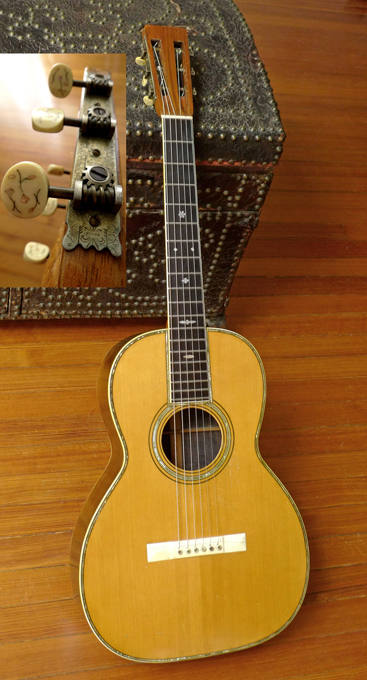 Exquisite, and a joy to play (… the top level, largest guitar that Martin made at the turn of the 20th century– with tone that shows off what Frank Henry Martin was proud of when he personally signed the inside of this instrument in April, 1903…)
Exquisite, and a joy to play (… the top level, largest guitar that Martin made at the turn of the 20th century– with tone that shows off what Frank Henry Martin was proud of when he personally signed the inside of this instrument in April, 1903…) -
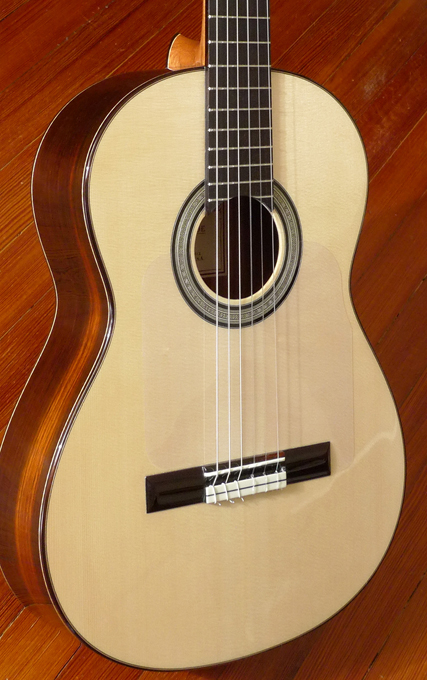 This new, custom made Lester Devoe Flamenco Negra is amasterpiece, from one of the world’s top luthiers. Lester Devoe needs nointroduction to the world’s great Flamenco players. The late, legendary Sabicasplayed a Devoe– and converted some of the great Flamenco players in Spain tothe fold. Paco De Lucia, and Vicente Amigo, among others, play Devoe Flamencoguitars. Paco De Lucia began playing a Devoe Negra guitar years ago– and thereare many Paco De Lucia recordings and feature films where Paco plays a DevoeFlamenco guitar.) This is the second custom guitar, that Lester has made for uswith select, old growth, quartersawn AAAAA Brazilian rosewood. Signed by LesterDevoe, 2012 (March).
This new, custom made Lester Devoe Flamenco Negra is amasterpiece, from one of the world’s top luthiers. Lester Devoe needs nointroduction to the world’s great Flamenco players. The late, legendary Sabicasplayed a Devoe– and converted some of the great Flamenco players in Spain tothe fold. Paco De Lucia, and Vicente Amigo, among others, play Devoe Flamencoguitars. Paco De Lucia began playing a Devoe Negra guitar years ago– and thereare many Paco De Lucia recordings and feature films where Paco plays a DevoeFlamenco guitar.) This is the second custom guitar, that Lester has made for uswith select, old growth, quartersawn AAAAA Brazilian rosewood. Signed by LesterDevoe, 2012 (March).- 650mm scale length
- Nut: 52mm
- Neck width at nut: 52mm
- 80 year old Brazilian Rosewood (pre-CITES) back and sides (Quartersawn).
- European spruce top
- Cedar neck
- Brazilian Rosewood headstock overlay, and bridge
- Brazilian Rosewood body binding, top and back
- Ebony fingerboard
- Sloane tuners
- Nitrocellulose lacquer finish
-
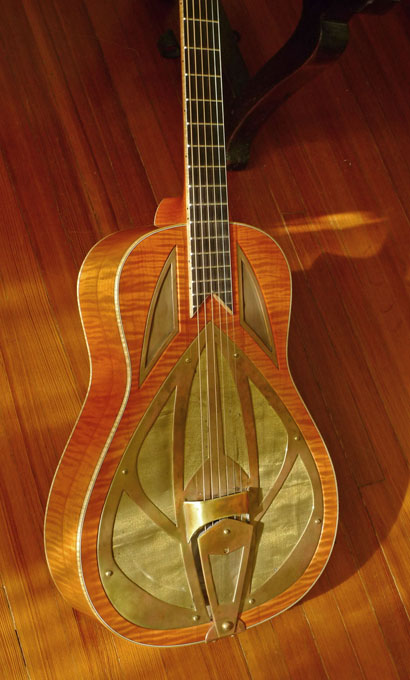 This stunningly beautiful, one-of-a-kind custom built resonator (from 2006, in beautiful crack-free condition and with only light wear) is from Tony Nobles, well-known luthier, and maker of instruments for Joe Walsh, Billy Gibbons and many other artists. The art deco ornamentation compliments an incredibly well built instrument, with meticulous attention to detail. Listen to/watch the video clip where guitar master Redd Volkaert put this instrument through some interesting jazz and blues paces.
This stunningly beautiful, one-of-a-kind custom built resonator (from 2006, in beautiful crack-free condition and with only light wear) is from Tony Nobles, well-known luthier, and maker of instruments for Joe Walsh, Billy Gibbons and many other artists. The art deco ornamentation compliments an incredibly well built instrument, with meticulous attention to detail. Listen to/watch the video clip where guitar master Redd Volkaert put this instrument through some interesting jazz and blues paces.- Spun-aluminum Quartermane biscuit-style cone (single-cone resonator)
- Solid curly maple, back top, and sides, with light tobaccoburst nitrocellulose lacquer finish
- Art deco coverplate, soundholes, and tailpiece of antiqued brass with a metal mesh covering
- Maple binding on body
- Custom torch inlay on headstock
- Curly maple neck
- Waverly tuners
- Scale: 24.4 inches
- Nut width: 1 7/8 inch
- String spacing at nut: 1 18/32
- Bridge spacing: 2 1/8
- Lower Bout: 14 1/2
- Upper bout: 9 1/2
- Body depth at bottom: 3 ¾ inches
- Body depth at neck joint: 3-20/32
-
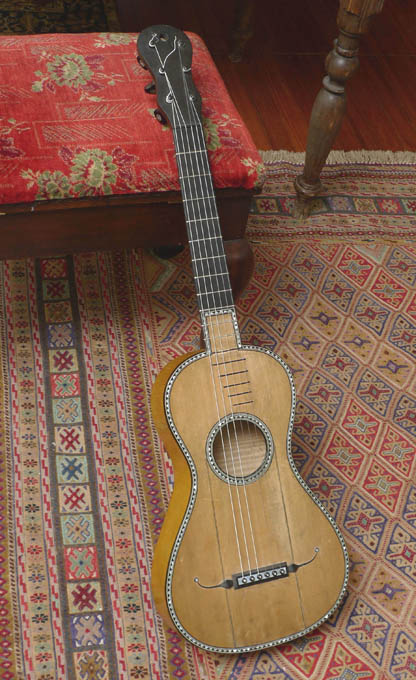 This fine and early example of the French guitar was made in Mirecourt, France, around 1800 to 1810. And sold through the famous Parisian dealer Koliker. It is a rare early example, as indicated by its rectangular bridge that does not have a separate saddle, but uses the top edge of the ebony rectangle as the saddle (this feature places it circa 1800, not like the more common 1820-1840 French guitars that have a more modern style bridge including a regular saddle). But for all its rarity, and exoticism to modern eyes, the most salient feature of this guitar is that it plays wonderfully. This is no museum piece to hang on a wall or shelf. This guitar is to play and enjoy. It plays beautifully, with all frets in tune. With no buzzing... I have had guitars from the 1960’s that do not play as well, in tune, and sound as well as this one. Even the action is perfect. The guitar has a wonderful tone, with a sweetness and brightness from the maple, and full bass response.
This fine and early example of the French guitar was made in Mirecourt, France, around 1800 to 1810. And sold through the famous Parisian dealer Koliker. It is a rare early example, as indicated by its rectangular bridge that does not have a separate saddle, but uses the top edge of the ebony rectangle as the saddle (this feature places it circa 1800, not like the more common 1820-1840 French guitars that have a more modern style bridge including a regular saddle). But for all its rarity, and exoticism to modern eyes, the most salient feature of this guitar is that it plays wonderfully. This is no museum piece to hang on a wall or shelf. This guitar is to play and enjoy. It plays beautifully, with all frets in tune. With no buzzing... I have had guitars from the 1960’s that do not play as well, in tune, and sound as well as this one. Even the action is perfect. The guitar has a wonderful tone, with a sweetness and brightness from the maple, and full bass response.- All original finish on the guitar
- Flamed solid Maple back and sides
- Spruce top, with no finish on the spruce… this is a characteristic of guitars from this time and place. While the back and sides of the guitar were French polished, the spruce top was left as natural wood, with no finish.
- One of the friction pegs is a modern replacement
- The two dark splices on the soundboard are later, but still 19th century, restorations, done as decorative flourishes.
- Scale length: 64.3 cm
- Length of body: 43.3 cm
- Koliker, Luthier Rue Croix-des-Petits Champs No. 24 A. Paris
-
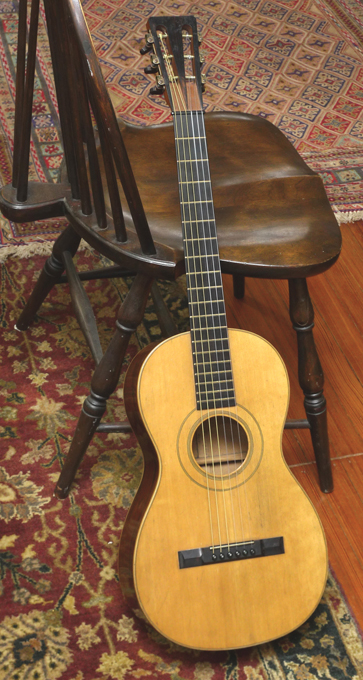 Circa 1860 parlor guitar style 1 built by well known luthier, James Ashborn of Wolcottville, CT, for William hall & son music store. Brazilian rosewood back and sides; Adirondack top; maple binding. This guitar is crack free save for a couple of minor finish cracks on back, and is 100% original, including all original finish, and down to original nut, original bridge (and saddle) that has never been off the guitar, and original bridge pins. From a just-published article in Vintage Guitar magazine: “Ashborn's design for the guitar was quite innovative for the early 19th century. Instead of making guitars fashioned after the typical parlor-style guitars, he made them in the Spanish style, by taking interior bracing cues from the Spanish while retaining the body of the English guitars. This included a fan brace pattern rather than the more common ladder pattern Ashborn guitars have a very complex dovetail V joint for attaching the head to the neck. The headstock was cut in roughly five steps, using some kind of tracing router, as suggested by the chatter marks on the inside ears of the pegbox. In addition to the complex head design, Ashborn made his own tuning machines in-house. They're made of brass, very much like contemporary machines, with worm gears, cog gears, and rollers. … Ashborn's shop was extremely advanced for its time, having a great deal of know-how and technology. Ashborn understood the need to have the technology as well as the skill, but more importantly he discovered a new way of making high-quality instruments that were affordable. He was able to create a factory environment where workers did what they were good at and, with practice, became very fast and consistent. With a new level of consistency in mass production, he created the path followed by other companies such as Martin, Gibson, and Taylor. Using designs ahead of his time, he was able to bring the sound and change to people who otherwise never would have been able to acquire an instrument of this quality.” This beautiful all-original and crack-free Ashborn guitar is one of the best-preserved examples in existence.
Circa 1860 parlor guitar style 1 built by well known luthier, James Ashborn of Wolcottville, CT, for William hall & son music store. Brazilian rosewood back and sides; Adirondack top; maple binding. This guitar is crack free save for a couple of minor finish cracks on back, and is 100% original, including all original finish, and down to original nut, original bridge (and saddle) that has never been off the guitar, and original bridge pins. From a just-published article in Vintage Guitar magazine: “Ashborn's design for the guitar was quite innovative for the early 19th century. Instead of making guitars fashioned after the typical parlor-style guitars, he made them in the Spanish style, by taking interior bracing cues from the Spanish while retaining the body of the English guitars. This included a fan brace pattern rather than the more common ladder pattern Ashborn guitars have a very complex dovetail V joint for attaching the head to the neck. The headstock was cut in roughly five steps, using some kind of tracing router, as suggested by the chatter marks on the inside ears of the pegbox. In addition to the complex head design, Ashborn made his own tuning machines in-house. They're made of brass, very much like contemporary machines, with worm gears, cog gears, and rollers. … Ashborn's shop was extremely advanced for its time, having a great deal of know-how and technology. Ashborn understood the need to have the technology as well as the skill, but more importantly he discovered a new way of making high-quality instruments that were affordable. He was able to create a factory environment where workers did what they were good at and, with practice, became very fast and consistent. With a new level of consistency in mass production, he created the path followed by other companies such as Martin, Gibson, and Taylor. Using designs ahead of his time, he was able to bring the sound and change to people who otherwise never would have been able to acquire an instrument of this quality.” This beautiful all-original and crack-free Ashborn guitar is one of the best-preserved examples in existence. -
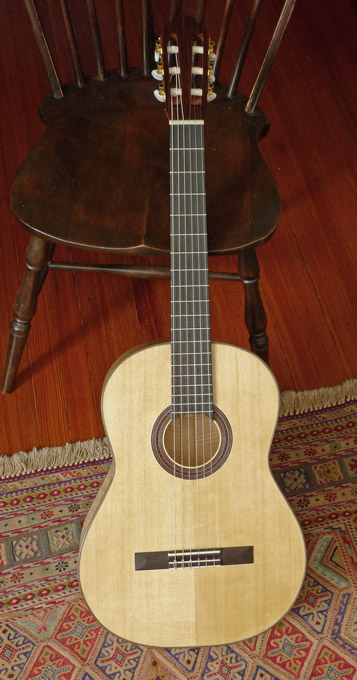 Joseph Redman, based in Abingdon, VA, makes some nice, hand made, yet affordable classical and flamenco guitars. Their low price tags don’t reflect the quality of materials in each instrument. This was a custom order, featuring European Maple back and sides, and all hand French polished by Redman. Nice, rumbling bass response. The Maple tone here, doesn’t show up in the trebles as much as it does in the bass– adding a Maple crispness to the bass strings.
Joseph Redman, based in Abingdon, VA, makes some nice, hand made, yet affordable classical and flamenco guitars. Their low price tags don’t reflect the quality of materials in each instrument. This was a custom order, featuring European Maple back and sides, and all hand French polished by Redman. Nice, rumbling bass response. The Maple tone here, doesn’t show up in the trebles as much as it does in the bass– adding a Maple crispness to the bass strings.- Finish: hand-rubbed French Polish
- 650mm Scale length
- European Maple back and sides
- Canadian Spruce top
- Ebony fretboard
- Neck: Spanish Cedar
- Bindings:
-
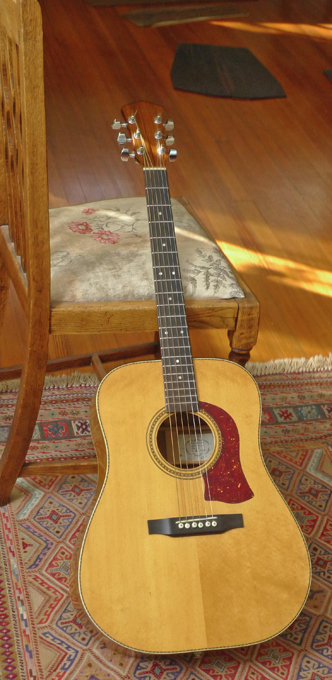 Stuart Mossman was one the country’s top luthiers in the 1970s and 80s– working in the tradition of the great American Dreadnought. According to an article in Vintage Guitar magazine: Stuart Mossman “…. began making guitars in 1965 and through his early efforts concentrated on experimenting with bracing of the tops. He spent four years building 40 or 50 prototypes in his garage at home. By the end of the decade, sensing a niche in the market for high quality handmade acoustics, he had incorporated S. L. Mossman Guitars in Winfield, Kansas and moved into facilities at Strother's Field outside of town. Mossman had noticed what was happening with major acoustic guitar manufacturers at the time. The folk music boom had pushed demand for acoustic instruments to an all-time high and while Gibson, Martin and Guild were increasing production, imports from the Pacific rim countries were beginning to exploit the lower end of the market. Mossman was concerned with what he saw as an erosion in materials, design, and craftsmanship in the construction of the traditional flattop acoustic guitar, particularly among the larger manufacturers as they rushed to meet the strong demand. Using only top-quality woods, a proprietary bracing structure, and old-world building techniques, Mossman guitars entered series production in 1970. ‘We were the first of the small manufacturers to make it as a larger company', Stuart Mossman recalls…” The original 70’s Mossman dreadnoughts are very well built, with attention to detail, and craftsmanship unsurpassed in this period. One of the hallmarks of the Mossman guitar is that each instruments has a paper label inside, with the serial number (that included the year date) and model. And the label was always signed or initialed by the craftsmen building that guitar (this one includes Stu Mossman’s initials: SLM). The Flint Hills model featured East Indian Rosewood back and sides, spruce top, ebony fretboard and bridge, and a unique inlay around the soundhole. This example is all original, and is in fine condition, with no cracks. Original West German Schaler tuners. It has an under-saddle pickup installed, and an input jack in the end pin. Tone is fine, and loud, reminiscent of a 60’s Martin– but with a little more punch in the mids and trebles– a perfect bluegrass instrument.
Stuart Mossman was one the country’s top luthiers in the 1970s and 80s– working in the tradition of the great American Dreadnought. According to an article in Vintage Guitar magazine: Stuart Mossman “…. began making guitars in 1965 and through his early efforts concentrated on experimenting with bracing of the tops. He spent four years building 40 or 50 prototypes in his garage at home. By the end of the decade, sensing a niche in the market for high quality handmade acoustics, he had incorporated S. L. Mossman Guitars in Winfield, Kansas and moved into facilities at Strother's Field outside of town. Mossman had noticed what was happening with major acoustic guitar manufacturers at the time. The folk music boom had pushed demand for acoustic instruments to an all-time high and while Gibson, Martin and Guild were increasing production, imports from the Pacific rim countries were beginning to exploit the lower end of the market. Mossman was concerned with what he saw as an erosion in materials, design, and craftsmanship in the construction of the traditional flattop acoustic guitar, particularly among the larger manufacturers as they rushed to meet the strong demand. Using only top-quality woods, a proprietary bracing structure, and old-world building techniques, Mossman guitars entered series production in 1970. ‘We were the first of the small manufacturers to make it as a larger company', Stuart Mossman recalls…” The original 70’s Mossman dreadnoughts are very well built, with attention to detail, and craftsmanship unsurpassed in this period. One of the hallmarks of the Mossman guitar is that each instruments has a paper label inside, with the serial number (that included the year date) and model. And the label was always signed or initialed by the craftsmen building that guitar (this one includes Stu Mossman’s initials: SLM). The Flint Hills model featured East Indian Rosewood back and sides, spruce top, ebony fretboard and bridge, and a unique inlay around the soundhole. This example is all original, and is in fine condition, with no cracks. Original West German Schaler tuners. It has an under-saddle pickup installed, and an input jack in the end pin. Tone is fine, and loud, reminiscent of a 60’s Martin– but with a little more punch in the mids and trebles– a perfect bluegrass instrument. -
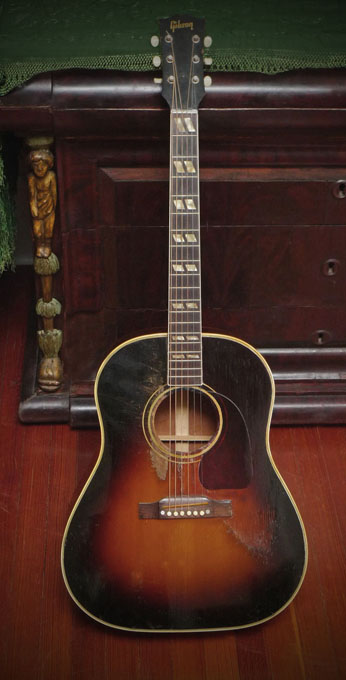 Crack-free, and superb tone. One of the finest sounding large bodied Gibsons we’ve ever heard.
Crack-free, and superb tone. One of the finest sounding large bodied Gibsons we’ve ever heard. -
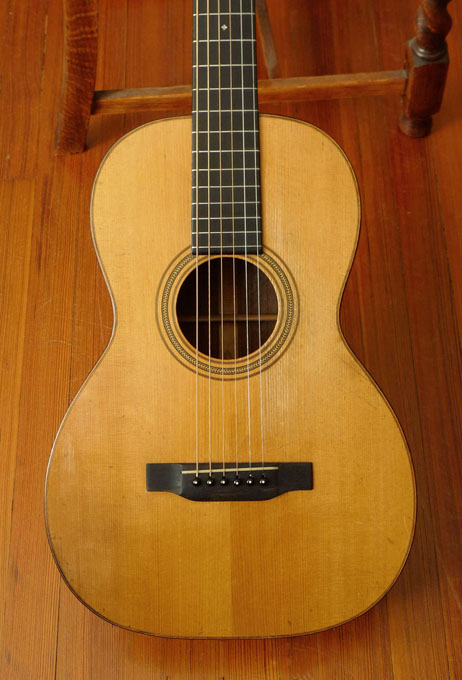 This is a wonderful Martin 0-21, but with “the best of both worlds”: the light build of 1924– combined with 1930’s robust, “braced for steel” construction. It left the factory in 1924, but it went back to Martin in 1934 for a neck set, new belly bridge, and to get set up fully for steel strings. Details below.
This is a wonderful Martin 0-21, but with “the best of both worlds”: the light build of 1924– combined with 1930’s robust, “braced for steel” construction. It left the factory in 1924, but it went back to Martin in 1934 for a neck set, new belly bridge, and to get set up fully for steel strings. Details below.- All original finish
- Original 1934 bridge, and bridge plate from Martin Factory
- Original saddle
- Original “arrowhead” design tuners. The first Waverly tuners showed up in 1924/25 and remained until after the war. The arrowhead design, seen here on the tuner plates, showed up also in 1924, still with the shafts placed underneath the gears / string posts.
- Crack free (there is one cleat inside guitar, on upper bout, back. There is no visible crack that goes through wood to inside, just a tiny finish crack on outside. No doubt the Martin luthier place the cleat there in 1934 as a preventative measure (that worked).
- The combination of the original thin-profile neck, with the braced-for-steel modifications by Martin factory in 1934, make for a very robust guitar– you can play it hard and it holds up and projects like a 30’s Martin.
- Sold by Martin factory and shipped to Rudolph Wurlitzer Co. in Chicago on March 18, 1924. (This guitar does not have “Wulitzer” stamps, rather the normal CF Martin Stamps in all the correct places. This is consistent with Martin/Wurlitzer timetable in “Martin Guitars: A Technical Reference” by Johnston and Boak, 2009, p. 248.)
- June 20, 1933: the owner wrote to Martin that instrument needed a neck set and the bridge was “adrift”. Martin replied on June 23 that the normal guarantee would probably cover this work.
- Owner sent the guitar to Martin on July 3, 1934. Martin reported back to owner on July 16 that readjusting the neck and regluing the bridge would be covered by the warranty, Martin also offered a “new” bridge (meaning belly bridge) for $1.50. Martin also said that some binding could be reglued and repaired for $3.00.
- Work done at Martin, July 1934. The luthier at Martin replaced the bridge with a 1934 spec ebony belly bridge, and replaced the bridge plate with a perfect, tucked, small maple bridge plate. Martin luthier signs underside of spruce top: "7-25-1934”, and put his initials (“W.T.W.”), right by the edge of the X-brace to the top/upper bout. Of course, the back was taken off the guitar to do the above work. But being perfectly done at Martin factory in 1934, there are no visible signs of that– back binding is perfect.
- Total repair bill from Martin factory in 1934: $4.50. Paid by check, and Martin return ships the 0-21 to owner on August 15th, 1934.
-
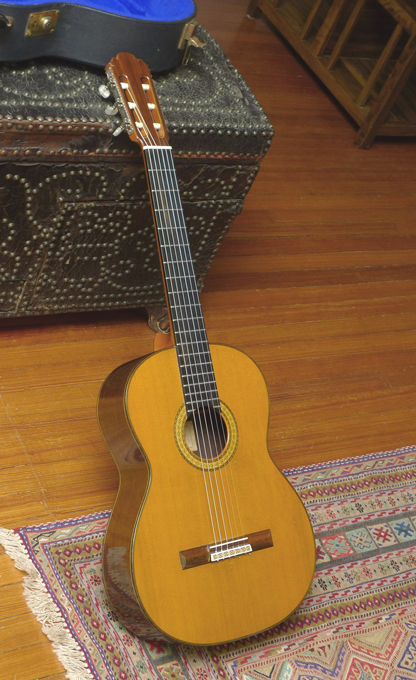 Another fine Kohno classical guitar from Masaru Kohno. This one combines a cedar top with Indian rosewood back and sides for a warm, clear tone. The best sounding Kohno 15 (or 20 for that matter) we’ve had.
Another fine Kohno classical guitar from Masaru Kohno. This one combines a cedar top with Indian rosewood back and sides for a warm, clear tone. The best sounding Kohno 15 (or 20 for that matter) we’ve had.- Cedar Top
- Indian Rosewood Back and sides
- Ebony Fretboard
- Deluxe Fustero tuners, with pearloid buttons
- Scale length: 660mm
- Nut: 52mm
- Condition is good. Several repaired cracks, all well-repaired:
- treble side, about 1/4 inch off fretboard: 3 2/3 inch
- bass side, 1 1/4 inch off fretboard: 4 ¼ inch
- 1/4 inch bass side of center seam, between bridge and soundhole: 4 inches
-
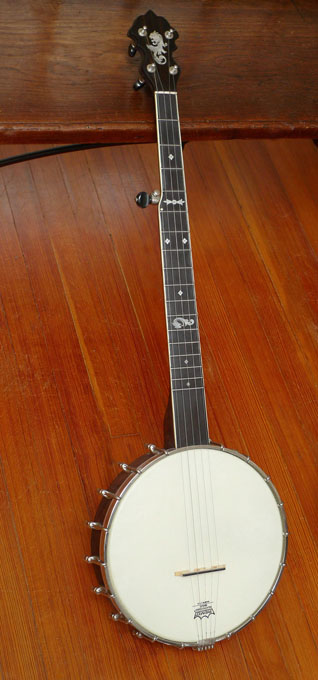 This is a one-of-a-kind custom banjo, from one of the country’s most respected luthiers, based in Appomattox, Virginia. I love this banjo for picking on the couch– it won’t put your back out, picking it up and putting it down, or crush your cat or your sweetheart. It’s lightweight, and with a custom-size head. But it packs beautiful full tone, not the tinny nasal sound from most open back banjos. It’s five or so years old, but with very little wear.
This is a one-of-a-kind custom banjo, from one of the country’s most respected luthiers, based in Appomattox, Virginia. I love this banjo for picking on the couch– it won’t put your back out, picking it up and putting it down, or crush your cat or your sweetheart. It’s lightweight, and with a custom-size head. But it packs beautiful full tone, not the tinny nasal sound from most open back banjos. It’s five or so years old, but with very little wear.- Dark stained maple rim, and neck
- 11 inch pot
- Ebony fretboard
- Engraved dragon inlay in peghead
- Custom MOP inlays
- Bound neck
- No Knot tail piece (Pat. Nov. 19 1901)
- 18 lug
- Brass hoop tone ring
- Dowell stick construction
- nut width 1-¼ inch
- scale: 25- ½ inches
- maple rim diameter: 10- ½ outside
- maple rim thickness: 7/16 inches
- Dark stained maple rim, and neck
- 11 inch pot
- Ebony fretboard
- Engraved dragon inlay in peghead
- Custom MOP inlays
- Bound neck
- No Knot tail piece (Pat. Nov. 19 1901)
- 18 lug
- Brass hoop tone ring
- Dowell stick construction
- nut width 1-¼ inch
- scale: 25-½ inches
- maple rim diameter: 10- ½ outside
- maple rim thickness: 7/16 inches
- With original case.
-
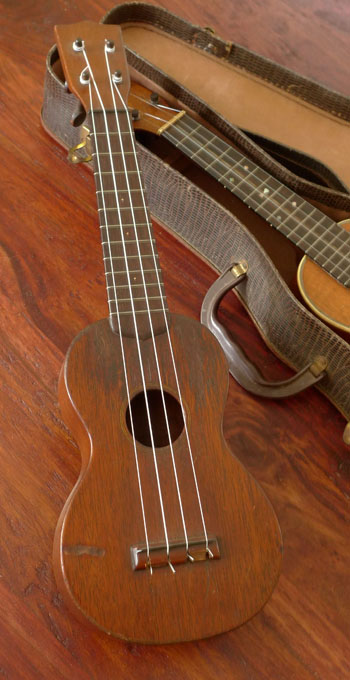 A pre-decal Uke from Martin. Style 0, with no body binding. Well worn, but 100% crack free.
A pre-decal Uke from Martin. Style 0, with no body binding. Well worn, but 100% crack free. -
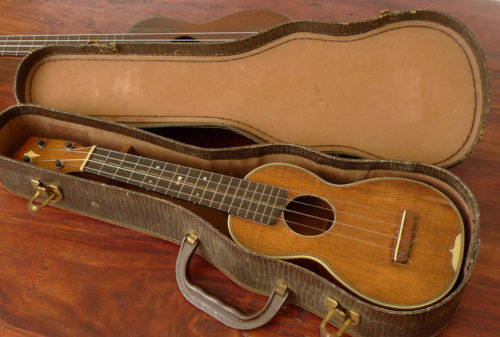 One of the first Martin 3K Ukeleles ever made. This is possibly a prototype, one of the first, all hand-made Martin 3K Ukeleles, made probably before the official introduction of the model by Martin in 1919-1920. It has many signs that it was the one of the first ones:
One of the first Martin 3K Ukeleles ever made. This is possibly a prototype, one of the first, all hand-made Martin 3K Ukeleles, made probably before the official introduction of the model by Martin in 1919-1920. It has many signs that it was the one of the first ones:- Ebony fretboard is hand-cut
- Fretboard inlays are hand-cut
- There is an "A" on the back of headstock... could be a marking by the Martin craftsmen in-house to indicate a prototype.
- Several cracks on back (repaired)
- Two cracks on top (repaired)
- There is one missing brace, a back brace, inside. Since ukeleles are so small, that brace has no real structural importance, so we decided not to replace it
- The sound hole was at some point enlarged slightly, either at the factory, or later. Probably later– so we’ll call it the Tony Rice model… this modification does add loudness
- The finish is all original.
- Original striped nut
- 3 lines inlaid down center of fingerboard.
- 7 ply side binding
- Celluloid ornament on top, behind bridge (known as the "parend").
- Small pearl paired-diamond inlays at fret 5, 7, 9– hand-cut. With the “bowtie” at the 7th fret
- Kite-shaped celluloid ornament on front of headstock
- Original friction pegs
- Ebony fretboard
- C.F. Martin & Co. stamp on back of headstock.
-
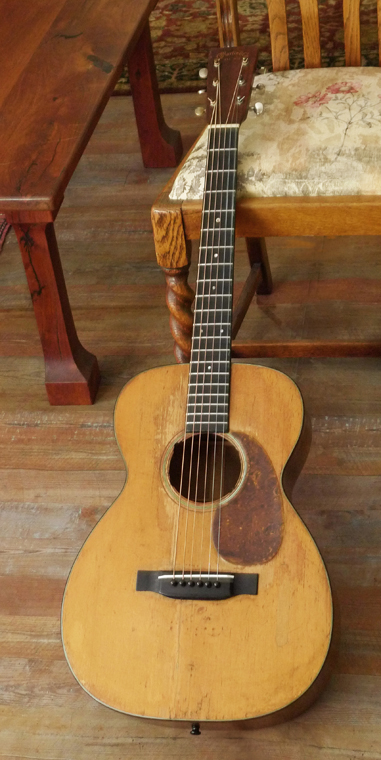 This guitar is probably among the first twenty Martins made in 1939 after the change in nut width on 14-fret models from 1 3/4" to 1 11/16", so yes it is 1 11/16. It has all original finish. Original tuners. Original maple bridge plate. It has multiple repaired cracks on top and sides (no cracks on back). Extensive play wear. New, but perfect, historically correct reproduction Ebony bridge.
This guitar is probably among the first twenty Martins made in 1939 after the change in nut width on 14-fret models from 1 3/4" to 1 11/16", so yes it is 1 11/16. It has all original finish. Original tuners. Original maple bridge plate. It has multiple repaired cracks on top and sides (no cracks on back). Extensive play wear. New, but perfect, historically correct reproduction Ebony bridge. -
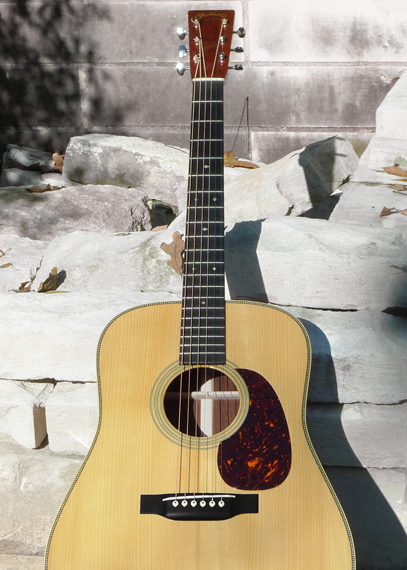 Martin has refined their “Authentic” series 1930’s recreations. When the first D-28A came out a about 5 years ago, it was Brazilian rosewood, with a price tag north of $20K. So when Martin decided to produce a Madagascar rosewood version, it was very welcome. In fact Martin learned from the earlier “Authentic” models and this guitar, one of the very first D-28 Authentics’s made with Madagascar rosewood, is a best of the breed– a recreation of the original 1937 D-28 model but now offered with Madagascar rosewood back and sides. And this instrument has a particularly good set of Madagascar.
Martin has refined their “Authentic” series 1930’s recreations. When the first D-28A came out a about 5 years ago, it was Brazilian rosewood, with a price tag north of $20K. So when Martin decided to produce a Madagascar rosewood version, it was very welcome. In fact Martin learned from the earlier “Authentic” models and this guitar, one of the very first D-28 Authentics’s made with Madagascar rosewood, is a best of the breed– a recreation of the original 1937 D-28 model but now offered with Madagascar rosewood back and sides. And this instrument has a particularly good set of Madagascar.- It’s in virtually unplayed, mint condition.
- Forward shifted hand-scalloped X-bracing
- Fingerboard Width At Nut: 1 3/4''
- Mahogany Blocks/Dovetail Neck Joint - Hide Glue
- Top: Solid Adirondack Spruce
- Top Braces: Solid Adirondack Spruce 5/16''
- Back Material: Solid Madagascar Rosewood
- Back Purfling: 28 Style Zig-Zag (Authentic)
- Side Material: Solid Madagascar Rosewood
- Neck Shape: Authentic 1937 Barrel & Heel
- Scale Length: 25.4''
- Bridge String Spacing: 2-5/16''
- Saddle: 16'' Radius/Long Bone
-
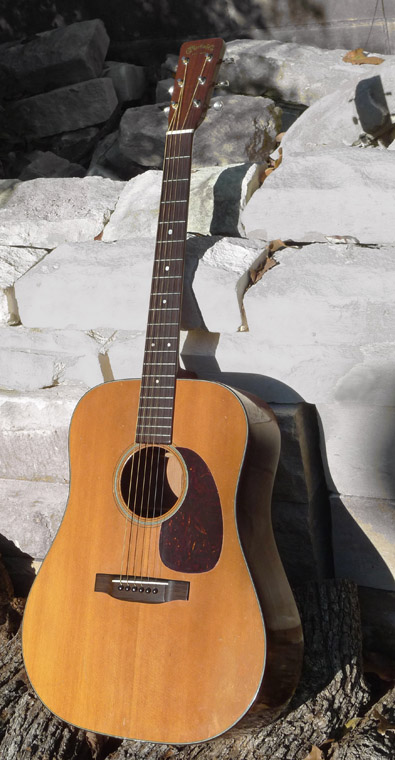 This is another great mid-fifties dread in unbelievable condition. It’s totally crack-free (also, not even a “pick guard” crack). Was acquired in 100% original condition: bridge, saddle, bridge pins, tuners, everything. Just had a neck set– resulting in great action, and tone/projection. With new condition Martin hard shell case.
This is another great mid-fifties dread in unbelievable condition. It’s totally crack-free (also, not even a “pick guard” crack). Was acquired in 100% original condition: bridge, saddle, bridge pins, tuners, everything. Just had a neck set– resulting in great action, and tone/projection. With new condition Martin hard shell case. -
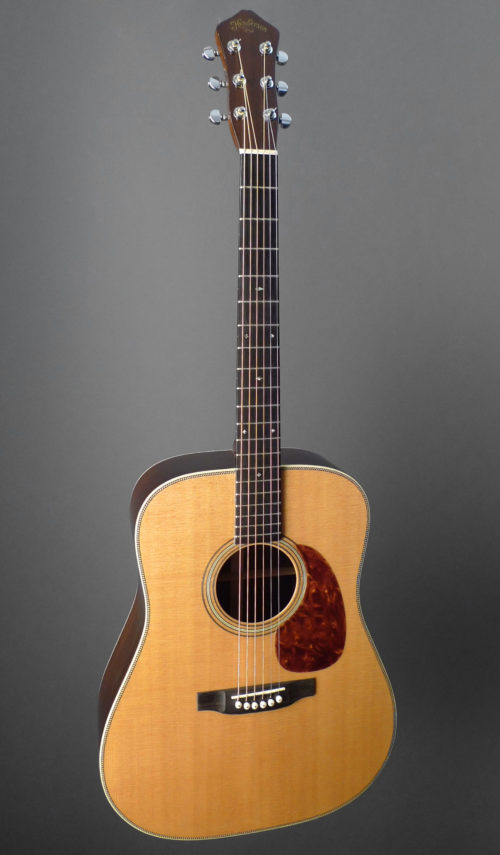 This week, to honor the just-announced winners of the 2018 Wayne Henderson Guitar Festival, we call out not an individual guitar, but rather one of the greatest American luthiers working today– and especially that luthier’s (and great player’s) work for youth in his area. We’re speaking of course of Wayne Henderson, and his legendary Festival. Every June Wayne Henderson hosts on of the most culturally important music festivals in the U.S., at the amphitheater in Grayson Highlands State Park near Henderson’s home and shop in Rugby, Virginia. The guitar- and generally music-loving attendees hear great music while supporting scholarships for young musicians in the area. And at the heart of the festival is the guitar competition. Click here to see the just-announced winners. And here’s a look at Fretboard Journal’s visit to the festival– and to Wayne Henderson’s luthier’s shop– a few years back. Click here for the article. .
This week, to honor the just-announced winners of the 2018 Wayne Henderson Guitar Festival, we call out not an individual guitar, but rather one of the greatest American luthiers working today– and especially that luthier’s (and great player’s) work for youth in his area. We’re speaking of course of Wayne Henderson, and his legendary Festival. Every June Wayne Henderson hosts on of the most culturally important music festivals in the U.S., at the amphitheater in Grayson Highlands State Park near Henderson’s home and shop in Rugby, Virginia. The guitar- and generally music-loving attendees hear great music while supporting scholarships for young musicians in the area. And at the heart of the festival is the guitar competition. Click here to see the just-announced winners. And here’s a look at Fretboard Journal’s visit to the festival– and to Wayne Henderson’s luthier’s shop– a few years back. Click here for the article. . -
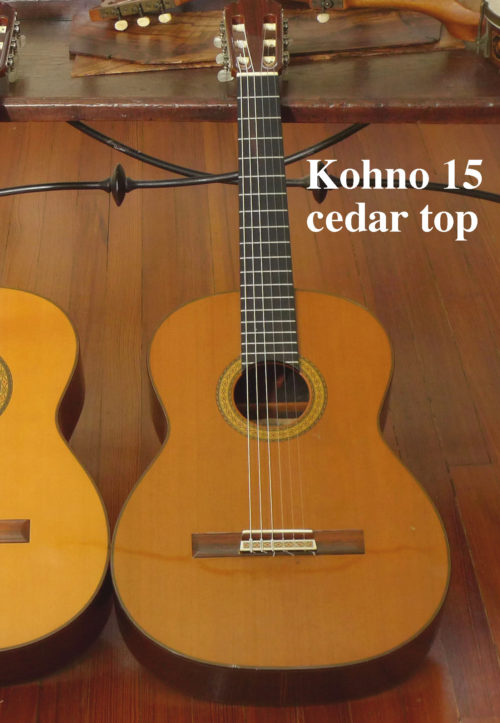 Kohno Classical Guitar. 1976 This instrument is being sold for a customer in Houston with a large collection of guitars. This guitar was originally purchased from VintageAmericanGuitar some five years ago– and its tone has aged and improved. The original Kohno design was specifically different from the high-end Spanish "concert" guitars of the day which had high action and beefy necks (and often long 664 or longer scale lengths). The Kohno necks were moderately thin in profile and shaped for very fluid playability. They’re a joy to play, physically. The 660 scale length– not overly long to begin with– actually “feels” shorter because of the neck design. (And the string spacing at the 2-inch nut: 1 11/16 inches, is also a great feature that adds to the great left hand feel.) We’ve seen/played many Kohnos– this one is unique in the combination of woods, and tone. Cedar top (not spruce), and Indian Rosewood back and sides. The combination, and this guitar’s age and unique voicing produce a dark, bass-rich tone and super clear and strong mids rarely found in a Kohno. It’s louder, darker and deeper than other Kohnos, yet is has great string separation– and the high E string is bell-like and loud.
Kohno Classical Guitar. 1976 This instrument is being sold for a customer in Houston with a large collection of guitars. This guitar was originally purchased from VintageAmericanGuitar some five years ago– and its tone has aged and improved. The original Kohno design was specifically different from the high-end Spanish "concert" guitars of the day which had high action and beefy necks (and often long 664 or longer scale lengths). The Kohno necks were moderately thin in profile and shaped for very fluid playability. They’re a joy to play, physically. The 660 scale length– not overly long to begin with– actually “feels” shorter because of the neck design. (And the string spacing at the 2-inch nut: 1 11/16 inches, is also a great feature that adds to the great left hand feel.) We’ve seen/played many Kohnos– this one is unique in the combination of woods, and tone. Cedar top (not spruce), and Indian Rosewood back and sides. The combination, and this guitar’s age and unique voicing produce a dark, bass-rich tone and super clear and strong mids rarely found in a Kohno. It’s louder, darker and deeper than other Kohnos, yet is has great string separation– and the high E string is bell-like and loud.- Solid Cedar top
- Solid Indian rosewood back and sides.
- Mahogany neck with 2 ebony strips
- Ebony fretboard
- 19 frets
- Rosewood bridge
- Gold engraved Fostero tuners. Fustero tuners are individually made by hand in Spain from the best materials…for decades they have adorned high end instruments built by Fleta, Ramirez, Kohno, Contreras, Bernabe and others.
- 660mm scale length
- 2" nut width
- String spacing at the nut: 1 11/16 inch
- Condition: One, repaired cracks:4 1/2 inches long, about 2 inches to the north (bass side) of the fretboard extension over the body.
-
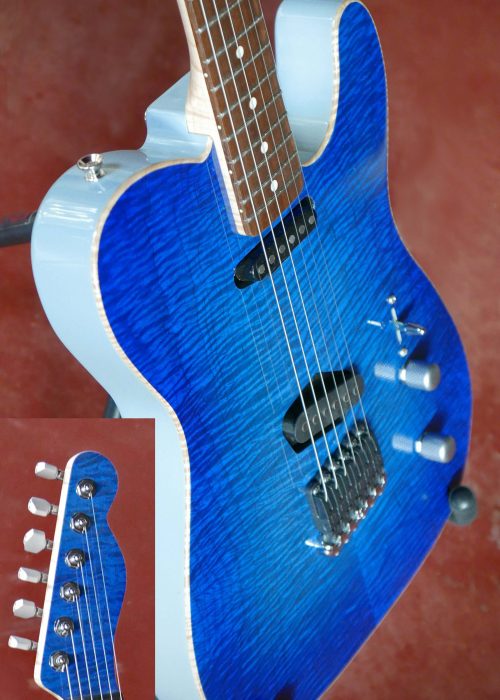 Tony Nobles "Coney Island Custom" Tele Guitar Master luthier Tony Nobles, based in Wimberly, Texas, needs little introduction. He’s been crafting custom guitars for years, quietly, without much hype, for artists ranging in style from Joe Walsh to Alejandro Escovedo. This guitar is fun, unique (it’s one of one), and draws on the DNA of some interesting sources. Starting with: the fretboard is made from rosewood salvaged from the actual Coney Island Boardwalk when they rebuilt it a few years ago. So it's a piece of history. Cut to chase on this unique guitar:
Tony Nobles "Coney Island Custom" Tele Guitar Master luthier Tony Nobles, based in Wimberly, Texas, needs little introduction. He’s been crafting custom guitars for years, quietly, without much hype, for artists ranging in style from Joe Walsh to Alejandro Escovedo. This guitar is fun, unique (it’s one of one), and draws on the DNA of some interesting sources. Starting with: the fretboard is made from rosewood salvaged from the actual Coney Island Boardwalk when they rebuilt it a few years ago. So it's a piece of history. Cut to chase on this unique guitar:- Top: bookmatched Maple; Natural Maple top binding
- Nitrocelulose lacquer finish
- Musikraft neck, maple, with rosewood fretboard made from salvaged wood from the actual Coney Island Boardwalk (when they tore down the old boardwalk for reconstruction, and the wood was preserved by architects/preservationists)
- 25.5" Scale
- Width at the Nut: 1-11/16"
- Width at the Heel: 2-3/16 (55.56mm)
- Number of Frets: 21
- Fret Type: Medium 6105
- Finger Board Radius: 10"
- Back of neck: natural, no finish
- Front of headstock, blue to match body
- Bridge: Schaller, imported from Germany, chrome
- Tuners: Sperzel Trimlok Locking Guitar Tuners 6-in-line Trim-Lok SATIN CHROME
- Volume and tone knobs: brushed satin chrome
- Pickups: Harmonic Design "54 special" for the bridge pickup; and Harmonic Design "MiniStrat" for the neck pickup
-
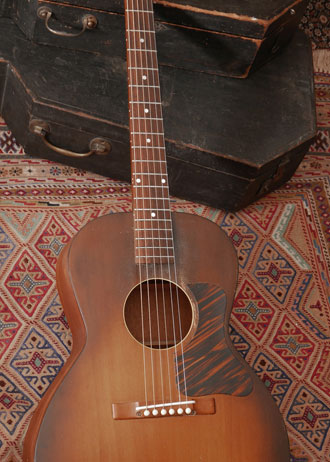 Read the full description below. If you're interested in this guitar, please call 512.922.8596 or contact us here.
Read the full description below. If you're interested in this guitar, please call 512.922.8596 or contact us here. -
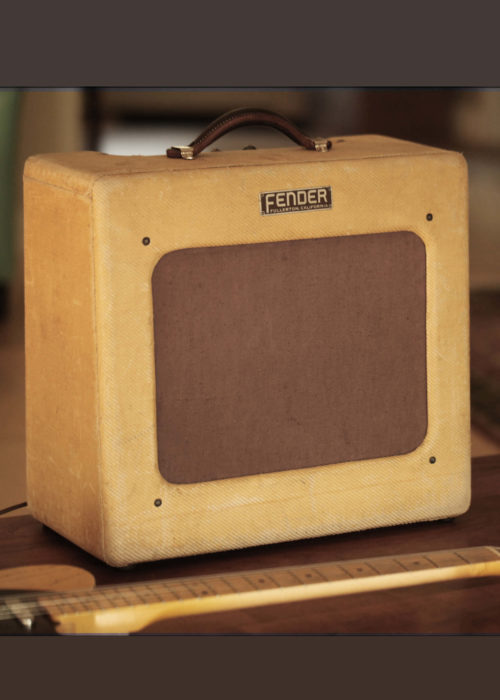 1951 Fender Deluxe Amplifier ... all it should be, and more... coming soon... . .
1951 Fender Deluxe Amplifier ... all it should be, and more... coming soon... . . -
Out of stock
 1957 Martin D-18 Guitar with Original Red Spruce Top. Read the full description below. If you're interested in this guitar, please call 512.922.8596 or contact us here.
1957 Martin D-18 Guitar with Original Red Spruce Top. Read the full description below. If you're interested in this guitar, please call 512.922.8596 or contact us here.